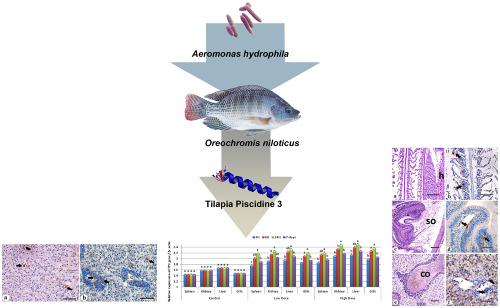当前位置:
X-MOL 学术
›
J. Pept. Sci.
›
论文详情
Our official English website, www.x-mol.net, welcomes your feedback! (Note: you will need to create a separate account there.)
Molecular characterization and immunohistochemical localization of tilapia piscidin 3 in response to Aeromonas hydrophila infection in Nile tilapia.
Journal of Peptide Science ( IF 2.1 ) Pub Date : 2020-08-18 , DOI: 10.1002/psc.3280 Karima F Mahrous 1 , Dalia M Mabrouk 1 , Mohamad M Aboelenin 1 , Heba A M Abd El-Kader 1 , Alkhateib Y Gaafar 2 , Abdelgayed M Younes 2 , Mahmoud A Mahmoud 3 , Wagdy K B Khalil 1 , Mohamed S Hassanane 1
Journal of Peptide Science ( IF 2.1 ) Pub Date : 2020-08-18 , DOI: 10.1002/psc.3280 Karima F Mahrous 1 , Dalia M Mabrouk 1 , Mohamad M Aboelenin 1 , Heba A M Abd El-Kader 1 , Alkhateib Y Gaafar 2 , Abdelgayed M Younes 2 , Mahmoud A Mahmoud 3 , Wagdy K B Khalil 1 , Mohamed S Hassanane 1
Affiliation

|
The antimicrobial activity of tilapia piscidin 3 (TP3) was determined in vitro against a locally isolated Aeromonas hydrophila. A 388 bp fragment was amplified from the TP3 cDNA and sequenced. The coding sequence (CDS) of TP3 was estimated to be 231 bp codes for 76 amino acids long and stop codon. In silico analysis was performed to detect both the signal peptide and the prodomain cleavage sites to follow the amino acids number 22 and 70, respectively. Based on this, a peptide 23 amino acids long with a remarkably high computed antimicrobial probability was synthesized and used in the subsequent experiments. The antimicrobial activity of TP3 was determined with minimum inhibitory concentration (MIC) and minim um bactericidal concentration (MBC) methods. TP3 exhibited relatively weak antimicrobial activities against the tested bacteria. A challenge experiment was then performed in Nile tilapia with low and high doses of A. hydrophila, followed by timely recognition; after 3, 6, 24 h, and 7 days of the specific TP3 gene expression, immunohistochemical localization was also performed. Histopathological examination revealed provoked inflammatory responses and congestion in the same organs of TP3 expression. Immunohistochemical localization showed that A. hydrophila induced tilapia fish to express TP3 after 24 h within the gills, intestine, hepatopancreas, spleen, and posterior kidney. In quantitative real time (RT)‐polymerase chain reaction analysis, the high dose showed higher mRNA expression levels than the low dose, and its expression levels increased in the A. hydrophila‐infected fish. It was therefore concluded that TP3 plays an essential role in fish immunity.
中文翻译:

罗非鱼piscidin 3响应尼罗罗非鱼嗜水气单胞菌感染的分子表征和免疫组化定位。
罗非鱼piscidin 3(TP3)对体外分离的嗜水气单胞菌的体外抗菌活性得到了测定。从TP3 cDNA扩增了一个388 bp的片段并进行了测序。TP3的编码序列(CDS)估计为231 bp编码76个氨基酸长,并终止密码子。进行了计算机分析,以检测信号肽和前结构域切割位点,分别遵循22和70位氨基酸。基于此,合成了具有23个氨基酸长的肽,该肽具有非常高的计算的抗菌可能性,并用于随后的实验中。TP3的抗菌活性通过最小抑菌浓度(MIC)和最小抑菌浓度(MBC)方法确定。TP3对被测细菌表现出相对较弱的抗菌活性。一个挑战实验,然后在尼罗河与低剂量和高剂量的执行罗非鱼嗜水气单,然后及时确认;在特定的TP3基因表达的3、6、24小时和7天后,还进行了免疫组织化学定位。组织病理学检查显示在相同的TP3表达器官中引发了炎症反应和充血。免疫组化显示,嗜水气引起的罗非鱼鳃,肠,肝,脾和肾后在24小时后表达TP3。在定量实时(RT) -聚合酶链式反应分析中,高剂量显示出比低剂量更高的表达水平,其表达水平在增加嗜水感染的鱼类。因此得出结论,TP3在鱼类免疫中起着至关重要的作用。
更新日期:2020-10-02
中文翻译:

罗非鱼piscidin 3响应尼罗罗非鱼嗜水气单胞菌感染的分子表征和免疫组化定位。
罗非鱼piscidin 3(TP3)对体外分离的嗜水气单胞菌的体外抗菌活性得到了测定。从TP3 cDNA扩增了一个388 bp的片段并进行了测序。TP3的编码序列(CDS)估计为231 bp编码76个氨基酸长,并终止密码子。进行了计算机分析,以检测信号肽和前结构域切割位点,分别遵循22和70位氨基酸。基于此,合成了具有23个氨基酸长的肽,该肽具有非常高的计算的抗菌可能性,并用于随后的实验中。TP3的抗菌活性通过最小抑菌浓度(MIC)和最小抑菌浓度(MBC)方法确定。TP3对被测细菌表现出相对较弱的抗菌活性。一个挑战实验,然后在尼罗河与低剂量和高剂量的执行罗非鱼嗜水气单,然后及时确认;在特定的TP3基因表达的3、6、24小时和7天后,还进行了免疫组织化学定位。组织病理学检查显示在相同的TP3表达器官中引发了炎症反应和充血。免疫组化显示,嗜水气引起的罗非鱼鳃,肠,肝,脾和肾后在24小时后表达TP3。在定量实时(RT) -聚合酶链式反应分析中,高剂量显示出比低剂量更高的表达水平,其表达水平在增加嗜水感染的鱼类。因此得出结论,TP3在鱼类免疫中起着至关重要的作用。


























 京公网安备 11010802027423号
京公网安备 11010802027423号